#seth typhon
Text
A very weird tangent inspired by my reading Don Webb's "Seven Faces of Darkness", centered around the figure of the Goat of Mendes and his Egyptian origins as well as connection to satanic solarisation and lust. I can also promise it gets pretty Bataillean by the end.
#solar myth#sun gods#goat of mendes#baphomet#solarisation#satan#the devil#seth typhon#satanism#ancient egypt#greek magical papyri#occult
3 notes
·
View notes
Text
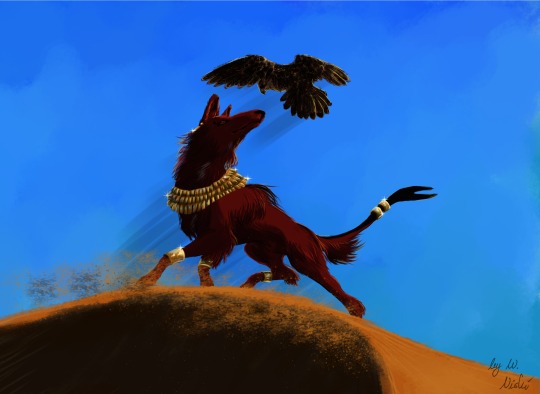
You will know it is him, because he is the only Sha with fur this long.
81 notes
·
View notes
Text






#Housamo#Tokyo Afterschoool Summoners#Benten#Kuniyoshi#Macan#Cthugha#Behemoth#Typhon#Bael#Astaroth#Ganglie#Seth#Ziz#Alp
93 notes
·
View notes
Text

39 notes
·
View notes
Text
Seth-Typhon's role in ancient magic
(This is an adaptation of an essay I wrote for my bachelor, which didn’t get published.)
Seth is not the most prominent or most called upon figure in ancient mediterranian magic, but I do think he’s one of the most interesting. Seth himself can be considered to be a controversial figure, with his fluctuating reputation and trickster nature. The same cannot be said for the Greek titan Typhon, who was viewed as thoroughly negative, being considered one of the most dangerous entities in the cosmos. From 500BC onwards the Greeks identified their Typhon with the Egyptian Seth, and so Seth-Typhon was born. Combined with the declining reputation of Seth, Seth-Typhon was largely viewed as a negative god. At the same time, he was called upon in magic spells for his power and dominion, even being called the ‘God of gods’.
So what is Seth-Typhon’s role in magic? And what made him appealing to magicians?
Seth-Typhon’s titles and powers in magical texts
At the end of this post I have included some excerpts from the PGM and curse tablets from the Athenian Agora so you can read these for yourself. Seth-Typhon is referred to in a number of in ways, of which these stand out to me:
-Ruler of the realm above
-master / lord
-God of gods
-the ground, sea, Hades, heaven, sun, moon, stars, and the whole universe tremble at his name
-whose name forcibly brings gods and daimons to it
-when his name is called, whomever you called will appear, god or dead man
-who controls the gods’ wrath
-who holds the royal scepter over the heavens
-who is the midpoint of the stars above
-the dreaded sovereign over the firmament
-who is fearful, awesome, threatening, irresistible
-hater of the wicked
-who holds sovereignty over the Moirai [Greek personifications of fate]
-capable of binding the ‘Aion of oblivion’
-called upon to ‘chill and destroy’
-Mighty Typhon
-‘Lord over blacking out and chilling’ (and sometimes ‘powerlessness’)
-taking away strength
Additionally, some other notable details from these texts:
-the magician identifies himself as ally of Seth, who helped him ‘in war with/against the gods’
-the magician is ‘conquered’ and ‘thrown down’ by the gods for this.
-Seth is capable of raising someone up (who has been thrown down), and granting power.
-the victim is ‘handed over’, which seems in parallel to ‘I brought Osiris before you chained’ in the PGM.
There is a lot to unpack here, and I won’t cover everything here. Relevant for this discussion of magic are the following themes: 1) Seth-Typhon as powerful, God of gods, master over the heavens, the whole universe trembling before him. 2) Seth-Typhon as controller of fate. 3) Seth-Typhon as binder of people, spirits and gods. 4) Seth-Typhon as fearful and terrifying, yet awesome and irresistible. 5) the magician identifying as an ally of Seth-Typhon, to gain his favour.
Now let’s dive a little deeper into why he is associated with these powers.
Seth-Typhon as the God of gods
As mentioned, Seth-Typhon is in some spells considered to be the God of gods. How did he get to be positioned in this role? Partially, this can be explained through the association between him and the Jewish God in the PGM. This association is clear through that Seth-Typhon is being referred to with names as Iao and Saboath, which are also used in reference to the Jewish God. D.R. Jordan mentions a theory that posits that the ancients made a connection between the Greek spelling of Iao and the Coptic spelling for ‘ass’ or donkey, the animal associated with Seth. This identification of Seth-Typhon with the Jewish god is also evident in the use of what Jordan calls ‘the Borphor syllabels’. These are syllables of unknown meaning that consist of a combination of ‘bar’, ‘bor/boor’, and ‘for/foor’, often associated with Hekate/Selene, but also with both Seth-Typhon and the Jewish god. Jordan theorizes that these syllables could represent general ‘outlandish sounds’ or barbaric language to the ancients, which would be fitting to use for deities of a destructive nature because of the connection between foreigners and violence/barbarism that both the Greeks and the Egyptians held.
With the Jewish God being the highest possible god, this identification lifts Seth-Typhon up to the same status. This made Seth-Typhon into a much bigger figure of cosmic proportions than he was before. This of course also gives him great powers.
Seth-Typhon’s power and allure to magicians
Why was Seth-Typhon attractive for magicians, considering all the other gods connected to magic? This relates back to Seth-Typhon as the God of gods, the highest cosmic entity. Naturally the God of gods holds a lot of power, and this power is attractive for magic practitioners to tap into. There are a number of instances in which the magic practitioner explicitly identifies with Seth-Typhon’s forces in order to persuade him to grant them powers. Specifically there are two prayers to Seth-Typhon in IV 154-285 of the PGM. Here the magic practitioner identifies himself as ‘the one who brought Osiris to you chained’ and as a soldier ‘who sided with you in the war with/against the gods’, among other things. The spell also makes it explicit that this is done in order to ask for help, for it is immediately followed by ‘raise up your friend [the reciter]’. A few lines later, the practitioner pleads: “O grant me power… so that, whensoe’er I tell one of the gods to come, he is seen coming swiftly to me in answer to my chant”. In this passage it’s clear that Seth-Typhon is powerful enough to command all other gods, forcing them to come when called. As ‘God of gods’ he seems to function much like other ‘highest god’ figures, like in the Eight Book of Moses. Like this highest god he is capable of commanding other gods that are considered to be below him in hierarchy.
Besides the PGM we see Seth-Typhon called upon in some curse tablets. Here he is not explicitly called upon as the highest cosmic figure, but does perform the same role of binding and additionally destroying people. He is however called ‘mighty’ and capable of binding the ‘Aion of oblivion’, the same powerful binding role as in the PGM. The curse tablets often start with that the magicians ‘hands over’ the victim to Seth-Typhon. This seems to parallel the identification of the magician as ally of Seth in the PGM; ‘I am he… who brought Osiris before you chained’. In addition to the role of binder, Seth-Typhon is considered to be capable of taking away the strength of people (though you may see this as a result of binding).
Application of power; binding, restraining, divination
Seth-Typhon’s powers then are those of strength, and the binding and controlling of both men and gods that this enables. His power is unparalleled as God of gods. Because of this, Seth-Typhon was also considered to be particularly effective. According to Giulia Sfameni Gasparra, Seth-Typhon was praised for his great cosmic power including his binding and dangerous aspects. Force this reason he is appropriately called upon in spells that seek to bind or destroy their targets, wether they are people (like in the curse tablets) or gods (in the PGM). His power of binding goes so far that he is is invoked a ‘charm to restrain’ in the Paris Papyrus (PGM IV) that ‘works on everything’.
This binding power is also useful for divination. The lines IV 154-285 in the Paris Papyrus are a divinatory spell, and the Leiden-London papyri contain a divinatory spell invoking Seth-Typhon as well. Divination in this sense meaning that a spirit is called upon to disclose information to the magician. Additionally, as master of the Moirai, he has knowledge and controle over fate as well (which relates to divination).
Perhaps Seth-Typhon's power reaches its peak in another spell from the Paris Papyrus ‘powerful spell of the Bear (a constellation associated with Seth) which ‘accomplishes everything’ (PGM IV 1331-1389). This truly attests to the all-encompassing power of Seth-Typhon.
Conclusions
What is Seth-Typhon’s role in ancient magical texts and why is he alluring for magicians? His role seems to be twofold, both relating to his strength and binding. In one way, practitioners call upon his power to bind, weaken, and destroy human targets. This is evident from the curse tablets. In a second but similar way, Seth-Typhon's strength is great enough to bind and control other deities and fate itself. This is not just useful in the binding enemies or gods to make them do your bidding, but also for practicing divination.
In these matters the practitioner does not just call upon Seth-Typhon as a strong deity, but as the mightiest, the God of gods, master over the universe and fate. Due to his cosmic power he was also considered to be very effective. We see this in the spells that ‘work on everything’ and ultimately in ‘powerful spell of the Bear which accomplishes everything’. His power is great enough to work on everything and to accomplish everything. Indeed, as D. R. Jordan argues, Seth-Typhon is ‘the deity par excellence in syncretic magical texts’.
Sources:
Papyri; the PGM (translation by Betz), Paris Papyrus, and Leiden-London Papyri (I don’t remember which translations I used I apologize).
D.R. Jordan, ‘Defixiones from a Well Near the Southwest Corner of the Athenian Agora’ in Hesperia: The Journal of the American School of Classical Studies at Athens, Jul. - Sep., 1985, Vol. 54, No. 3, pp. 205-255. Published by: The American School of Classical Studies at Athens.
Giulia Sfameni Gasparra, ‘Egyptian Theological Lore in PGM IV: a religious-historical commentary’ in The Wisdom of Thoth. Magical Texts in Ancient Mediterranean Civilisations, 2015, pp. 111-119. Edited by Grazyna Bakowska-Czerner, Alessandro Roccati, Agata Swierzoska. Published by: Archeopress publishing.
Excerpts:
PGM
L 179-200
"O mighty Typhon / I ruler of the realm Above and master, god of gods, O lord ABERAMENTH~OU (formula),
O dark's disturber, thunder's bringer, whirlwind, Night-flasher, breather-forth of hot and cold, Shaker of rocks, wall-trembler, boiler of the waves, disturber of the sea's great depth, / ERBET AU TAUI MENI,
I'm He who searched with you the whole world and Found great Osiris, whom I brought you chained. I'm he who joined you in war with the gods (but others say, “against the gods").
I'm he who closed heav'n's double gates and put to sleep the serpent which must not be seen, Who stopped the seas, the streams, the river currents Where'er you rule this realm.
And as your soldier I have been conquered by the gods, I have Been thrown face down because of empty wrath. Raise up your friend, I beg you, I implore; Thrown me not on the ground, O lord of gods, AEMINAEBAROTHERRETH~RABEANIMEA, O grant me power, I beg, and give to me This favor, so that, whensoc'r I tell One of the gods to come, he is seen coming Switfly to me in answer to my chants, … [l200]
L 218; Lord, god of gods, master, daimon.
L245; But you are not unaware, mighty king and leader of magicians, that this is the chief name of Typhon, at whom the ground, the depths of the sea, Hades, heaven, the sun, the moon, the visible chorus of stars, the whole universe all tremble, the name which, when it is uttered, forcibly brings gods and daimons to it. This is the name that consists of 100 letters. Finally, when you have called, whomever you called will appear, god or dead man
A protective charm:
L 261; "I call you who did first control gods' wrath, You who hold royal scepter o'er the heavens, You who are midpoint of the stars above, You, master Typhon, you I call, who are / The dreaded sovereign o'er the firmament. You who are fearful, awesome, threatening, You who're and irresistible And hater of the wicked, you I call, Typhon, in hours unlawful and unmeasured, You who've walked on unquenched, clear-crackling fire, You who are / over snows, below dark ice, You who hold sovereignty over the Moirai [Greek personifications of fate], …”
Jordan’s curse tablets/defixiones:
“"('Borphor' syllables) -babaie, mighty Betpyt, I hand over to you Eutychian, whom Euty- chia bore, that you may chill him and his purposes, and in your dark air also those with him. Bind in the unilluminated aion of oblivion and chill and destroy also the wrestling that he is going to do in the . .. this coming Friday. And if he does wrestle, in order that he may fall and disgrace himself, Mozoune Alcheine Perpertharona laia, I hand over to you Euty- chian, whom Eutychia bore. Mighty Typhon Kolchoi Tontonon Seth Sathaoch Ea, Lord Apomx Phriourinx over the blacking out and chilling of Eutychian, whom Eutychia bore, Kolchoicheilops, let Eutychian grow cold and not be strong this coming Friday, but let him be weak. As these names grow cold, so let Eutychian grow cold, whom Eutychia bore, whom Aithales promotes."”
“"('Borphor' syllables) -babaie, mighty Bepty, I hand over to you Attalos ... in the wres- tling . . . completely, but fall, Monoune Alcheine Pepertharona Iaia, I hand over to you Attalos the ephebe, son of Attalos. Mighty Typhon Kolchloi Tontonon Seth Sathaoch Ea, Lord Apomx Phriourinx over blacking out and chilling and powerlessness, Kolchoichei- lops, let Attalos the ephebe grow cold and do not let him wrestle (and come out) first. As these names grow cold, so too let Attalos' name and breath, impulse, knowledge, reckoning grow cold. Let him be deaf, dumb, mindless, having no impulse ... wrestling, not having any strength at all."
#Seth#Typhon#kemetism#kemeticism#PGM#idk what other tags are relevant#idk if people find this interesting#feel free to engage with this in discussion#or generally let me know what you think#this took way too long to write I'm going to bed I hope you enjoy
8 notes
·
View notes
Photo
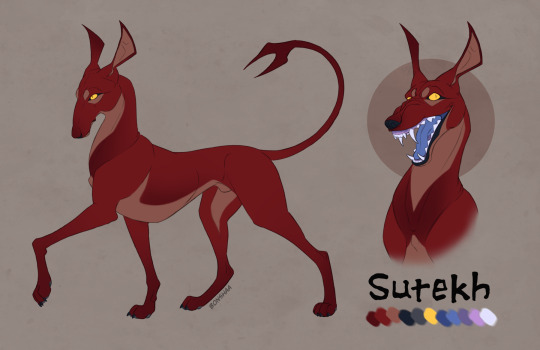
My take on Set's fursona. I like the idea of his insides being cooler than his outsides.
Socials
Posted using PostyBirb
#seth animal#ancient egypt#set animal#sutekh#seth#seth god#sha#sha animal#Typhonic beast#set god#set#Egyptian mythology#my art#ref sheet
127 notes
·
View notes
Text
a lot of people say that seth is the zeus of the ennead and all i can say to that is atleast he pulles out on time.
#yea saw that for ths first time#and immediately thought that#guy has great timing#considering. everything.#ancient egyptian mythology#egyptian mythology#egyptian gods#set#seth#sutekh#typhon#setekh#setesh#god set
7 notes
·
View notes
Text
Mythological doodles

#classical mythology#mythology#norse mythology#aztec mythology#egyptian mythos#greek mythology#art#doodle#quetzalcoatl#cerberus#xolo#xoloitzcuintle#ahuizotl#garm#garmr#set#seth#set animal#typhonic beast#ammit#artists on tumblr#traditional art#sketch#random doodles#image id in alt text
5 notes
·
View notes
Photo

In ancient Egyptian religion, the god Set was initially revered as a deity of foreigners and storms. However, due to certain later political tensions, he would later come to be demonized. This eventually resulted in interpretatio graeca conflating him with the father of all monsters, Typhon.
10 notes
·
View notes
Text
Alan Wake and The Implications™️ of Gnosticism as told by Carl Jung (1916)
So in AW2 NG+, there is a new video called "Spiral," where he ruminates on the implications of what the Spiral could mean (spoilers below, and a very long post ahead)!
"There are loops beyond these loops. Vast, complex super structures. Beyond what's happening to me now, ahead of me. And I'm there as well. A version of me, something I have become- some elevated, enlightened version- an archon, a demiurge, a demon of some sort- playing a secret game."
Now this is veeeery interesting to me.
In the Gnostic religion, The Demiurge (literally "artisan" in Greek) is described as a creator of the material world. He is the God of the world, but not the God of the universe. Think Cronus or Odin, under Uranus and Burí. The Demiurge cannot create something out of nothing. He takes matter, already existent and created by the upper god, and turns it into our world, though it comes out imperfect due to the matter being imperfect.
Then, we have another Greek word admist his monologue: the "archon." The archon is Greek for "ruler" but in Gnosticism, it is the builder(s) of the universe, composed of a team. There's usually seven, and each one rules a planet.
And finally, the demon. That's self-explanatory. In Gnosticism, the definition is interchangeable with the Archons. The Archons are demons and the demons are Archons. Yes, this is relevant.
What I find interesting is the intersection where these definitions meet, the center of the Venn diagram. The Demiurge, the Archon, and the Demon is Yaldabaoth, The Son of Chaos and The Prince of Darkness. He is also known in some iterations as Samael, the Angel of Death, and is primarily viewed as the precursor to our modern day Satan, as well as the Gnostic equivalent to Seth, Saturnus/Cronus, and Typhon. He is described as having a face made of "half flame, half darkness, defiled with blood."
If you ask what his morality is, you will spur a fishtfight among the occult (as I found out by perusing the various forums and subs). He is generally considered evil or amoral, but he used to be depicted as a genuinely "good" God. He is usually described as arrogant, a "fiery nature," ignorant of higher powers and jealous of other gods.
Now, Jung further developed his idea of the Demiurge and Archon and Demon from Yaldabaoth, giving him the name of Abraxas, as taught by Basilides. Little is known about Abraxas, as the sources beyond Jung are scarce, though his name dates back to the ancient Greeks. The church burned much of the text that held his name. The Catholic Church outright banned him for being a pagan God and a demon. He is the God of time, and is more powerful and more dualistic than the aforementioned Yaldabaoth (both morally and figuratively) . He was a prominent figure in his book, *Seven Sermons to the Dead,* where he had this to say about him:
"That which is spoken by God-the-Sun is life; that which is spoken by the Devil is death; Abraxas speaketh that hallowed and accursed word, which is life and death at the same time. Abraxas begetteth truth and lying, good and evil, light and darkness in the same word and in the same act. . . He is the God of the cosmos, extremely powerful and fearful. He is the creative drive, he is form and formation, just as much as matter and force, therefore he is above all the light and dark Gods. He tears away souls and casts them into procreation. He is the creative and created. . . His power is the very greatest, because man does not perceive it at all. He is magnificent even as the lion at the very moment when he strikes his prey down. His beauty is like the beauty of a spring morn. To see him means blindness; To know him is sickness; To worship him is death; To fear him is wisdom; Not to resist him means liberation … Such is the terrible Abraxas … He is both the radiance and the dark shadow of man. He is deceitful reality."
Abraxas is duality, the God and the Devil combined in one. He is the beginning and the end. The first word and the last.
Anyway, we reach the part where he has successfully Ascended. He pronounces himself the "Master of Many Worlds." He becomes, in this sense, an "archon, a demiurge, a demon," and I can only imagine what that entails. Talk about a character arc!
#alan wake 2 ng+#aw2#alan wake 2#alan wake ii#alan wake spoilers#alan wake 2 spoilers#alan wake ng+#Alan wake
79 notes
·
View notes
Text
I have located an early Christian discourse in which Satan is explicitly linked to the Titans, possibly to Typhon by extension. Both the Christian Origen of Alexandria and the pagan Celsus agree on the myth of the Titanomachy as the basis of the myth of the Fall of Satan.
Celsus, as quoted by Origen, accused Christians of impiety by posing an adversary to God - that being The Devil, or rather Satan. Celsus argued that Christianity poses a God that desires to do good but is helpless to do it because he has someone (Satan) counterveiling his will. Then, Celsus discusses ancient mythology concerning war among the gods. He focuses specifically on a myth told by Pherecydes of Syros, in which in the gods Kronos and Ophioneus raise their armies against each other in a battle to determine who will rule the cosmos.
At this point we need to step back a bit. Ophioneus, or Ophion, is the name of a serpent deity who seems to represent the forces of chaos. In some myths, Ophioneus is presented as the first divine ruler of the cosmos, though Pherecydes doesn't agree with that. As for Kronos, it is possible that in Pherecydes' myth this refers to both the Titan Kronos and Chronos the personification of time. The two figures are not traditionally conflated with each other, but it seems that Pherecydes probably did interpret them as being the same deity. In Pherecydes' myth, Kronos and Ophioneus battle each other before the ordering of the cosmos begins, though the full account of this battle is not entirely clear. Celsus believed that the loser of this battle, Ophion, was cast into the ocean (or rather Oceanus).
Some fragments seem to support the notion that it is Oceanus rather than Tartarus that Ophion is cast down into. But Ophioneus seems to also be considered identical or parallel to Typhon, who, in Greek mythology, was cast down into Tartarus or under Etna after his defeat by Zeus. It is possible that Ophion may have been thought to be born in Tartarus, which Pherecydes depicts as a cave below the earth, whereas Typhon was also born in a cave as the son of Gaia (earth) and Tartaros.
One thing to note is that, for Pherecydes, unlike many other ancient cosmogonies, it seems there is no primordial chaos that precedes an act of primeval demiurgy resulting in cosmic order. Instead, the forces of order and chaos existed besides each other forever and in conflict. For Pherecydes there was also no creation out of nothing. Instead, three gods were the first to exist all along: Zas (Zeus), Chthonie (Ge/Gaia), and Kronos/Chronos. He believed that these gods existed eternally, and that Chaos somehow came to be with no explanation.
Anyway, Celsus brings up Pherecydes' myth while discussing the concept of Satan, and then says that the Greek myths concerning the Titans and/or the Giants, and the Egyptian myths concerning Typhon (obviously meaning Set in this context) shared a similar symbolic meaning. He also relates that Hepheastus told Hera that he once felt the might of Zeus and hurled down from Olympus, and that Zeus boasted to Hera of how he bound and hung her in golden chains and hurled all the gods who opposed him from Olympus, as if to relate these to the Fall.
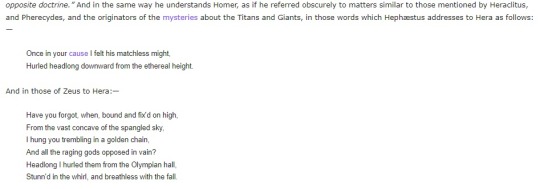
Celsus then does something interesting: he identifies the words of Zeus to Hera with the word of God to matter, arguing that this signifies matter that was originally was in discord before God then took and bound it together and arranged it with law, and then banished disorder. Demons who create disorder in the cosmos are related in Celsus' analogy to Titans and rebelling gods: they are chastised and hurled down. Tartarus, according to both Celsus and Pherecydes, is the place where Zeus banishes disorderly or insolent gods: in a word, prison.
Origen seems to actually agree with this analogy. In fact, in Book 4 of Against Celsus, Origen referred to "earthly demons, who delight in frankincense, and blood, and in the exhalations of sacrificial odours, and who, like the fabled Titans or Giants, drag down men from thoughts of God". Moreover, Origen argued that the writings of Moses mentioned a "wicked one" and his "falling from heaven" before the time of Homer and Pherecydes. Origen believed that Satan was the serpent that tempted Adam and Eve and that this was the original myth behind Ophioneus. If Origen interprets Satan as Ophioneus, then I would argue that he implies this connection for Typhon, and the Titans and Giants in relation to his demonic host. Origen also says that Satan is the "destroying angel" and the scapegoat Azazel.
This is interesting to consider in light of Plutarch and other sources whereby Typhon Seth is represented as a sacrificial animal. For Plutarch, Typhon is destined to never be completely defeated, and his power resides in the sacrificed animals and their slain blood, which, for Plutarch, ultimately nourishes the cosmos at least in the act of sacrifice, which pleases the powers of Osiris and Isis.
In any case, Origen seems to agree with Celsus on the Titanic-Satanic analogy, with the difference being that Celsus thinks the Christians were simply imitating pre-Christian myths while Origen thinks the Christian narrative preceded those same myths.
It might be worth noting that 2 Peter 2:4 says that God did not spare the angels who "sinned" against him, and that he threw them into "the pit". This is sometimes rendered as "hell", but in the Greek New Testament "the pit" is translated as Tartarus. Yes, none other than Tartarus, the prison of the Titans, and perhaps of Typhon and Kronos. From the pagan (or at least Celsian) standpoint at least, the parallels could not be clearer than this.
#satan#typhon#seth typhon#celsus#origen#greek mythology#titanomachy#titans#pherecydes#ophion#ophioneus#serpents#paganism#roman polytheism#tartarus#the fall#the fall of satan
5 notes
·
View notes
Text
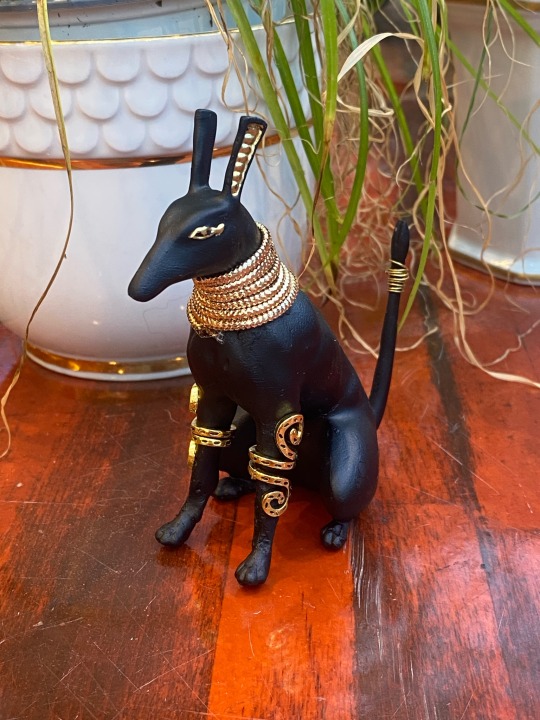

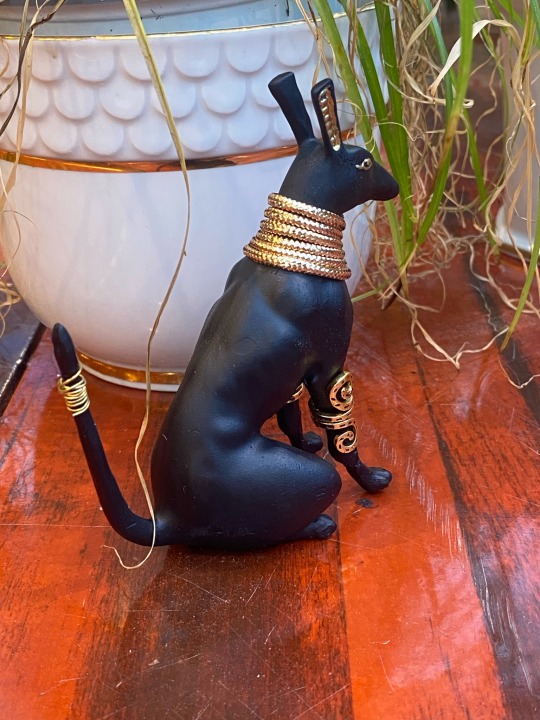
Look at him ❤️
My imperfect little boy, around 10cm high and with a lot of quirks.
In the future, I will print a bigger version and re-adjust the supports so there will be fewer bumps and nooks, but this is my “firstborn” so to speak and I love him all the same.
Btw, I left out the jewelry in the modeling process on purpose so that it is possible to decorate the figure to ones own liking.
#seth#setech#sutekh#seth animal#typhonic beast#sha#black#gold#figure#figurine#ennead#ancient egypt#egyptian mythology#egyptian god#3d printing#3d art#3d model#3d
46 notes
·
View notes
Text





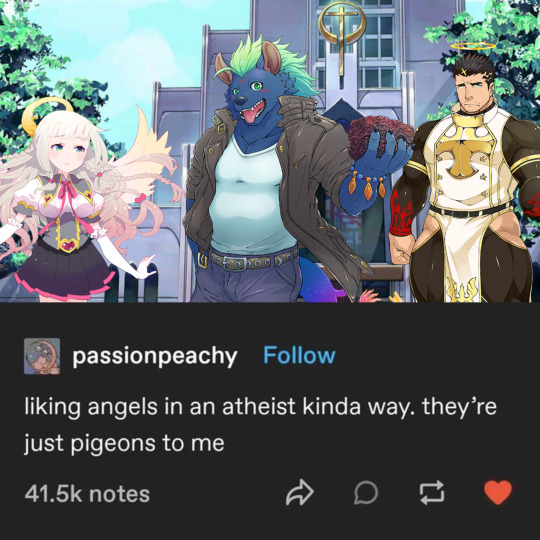
#housamo#tokyo afterschool summoners#nyarlanthotep#gabriel#zabaniyya#shino#seth#ganglie#typhon#yasuyori#surtr#babalon#belphegor
33 notes
·
View notes
Note
If you want more confusing demons to work with, I highly recommend Seth
Seth - Day 43 (Request)
Race: Vile
Alignment: Dark-Chaos
May 21st, 2024

Ancient Egyptian mythology is weird, even as far as most mythologies go. Vastly different tales and retellings form a winding game of telephone that makes the truth of already obscure myths hard to track, but if one thing is for sure, the myths we do know about paint a fascinating picture of intertwined lives and cycles of life, death, and rebirth. If there's one group of figures prominent throughout, however, it'd have to be the central pantheon, and easily the most antagonistic of that group could be extrapolated into today's Demon of the Day, Seth.
The desert winds are controlled by this divine lord of chaos, one who represents and stands for the great sands of Egypt, sandstorms, and the harsh reality of nature and survival as a whole. Set could easily be seen as the main villain of Egyptian mythology, but like most things in mythology, it's not quite that simple- in Ancient Egypt, he actually appeared to be a figure who was cruel but not ignoble, and even assisted humanity at times. Earlier versions of the myth of Ra state that he actually helped fight off the great serpent Apep when the sun god traveled through the murky depths of the afterlife during night, but this appears to have been phased out as time went on.
A part of why Set is now viewed as outright evil, as many historians believe, is due to his role as an usurper- Set was a prick, to say the least, even in his more sympathetic iterations. In the myth of Osiris, a myth commonly seen as the most important in Ancient Egyptian literature, he is the one who was responsible for the death and mutilation of Osiris due to wanting the throne the god of Fertility held. Of course, Osiris's sister-wife Isis, (yes, Egyptian mythology had a lot of incest. I don't know why,) ended up recovering the pieces of Osiris... save for, ehm, the family jewels, but Set's role in this story has not gone unnoticed throughout the years.
Set was bastardized, quite simply, and literally, into being an outright villain. This isn't to say he wasn't an absolute prick, of course, but as the mythology went on, he went from a foul-mannered but still noble figure to a character comparable to the Devil. Ironically, he ended up getting intermixed with his mortal enemy Apep, and given his lack of a physical animal that isn't... ambiguous, to say the least, a lot of depictions of him end up portraying him as a serpent or dragon himself. An ironic twist of fate, given his hatred of the dragon he was eternal enemies with, but alas, that's what history does to you.
Also notable is Set's association with foreigners and xenophobia- due to his added-on role later in Egyptian history as becoming the god of vagrants, he became inherently more villainous due to the xenophobia prevalent throughout a good majority of history, not just in egypt. Even now, the fear of foreigners paints him in an even deeper shade of black, making him look as though he was a villain through-and-through.
In SMT, his first depiction actually dates back before even the first game- no, he originates in Digital Devil Story 2, wherein he ends up teaming up with Apep and Typhon and becoming the main villain of said story. Now, I haven't read the Digital Devil Story series, unfortunately, but from what I can tell, his depiction in the series has mostly gone unchanged from the origin of the series itself. True to the common conflation of Set and Apep, the depiction of this overlord of desert sands is very draconic, being a black wyvern. In earlier games, he was even more explicitly snake-like, as noted in his portrayal in DDS2.

In Megami Tensei, up until SMT II, his design was almost Dragon Ball adjacent, which is frankly bizarre to me, but I kinda dig it.

Throughout the series, Set has been a powerful physical attacker typically in the mid-late game, and he's appeared in almost all entries to-date, including spinoffs like Persona. He's a very important figure in the series as well, having some story significance to my knowledge in one or two of the games, specifically in, you guessed it, SMT II.
Overall, Seth's appearance and lore make a fascinating deep-dive into mythology, as well as the history of Shin Megami Tensei in and of itself!
20 notes
·
View notes
Text

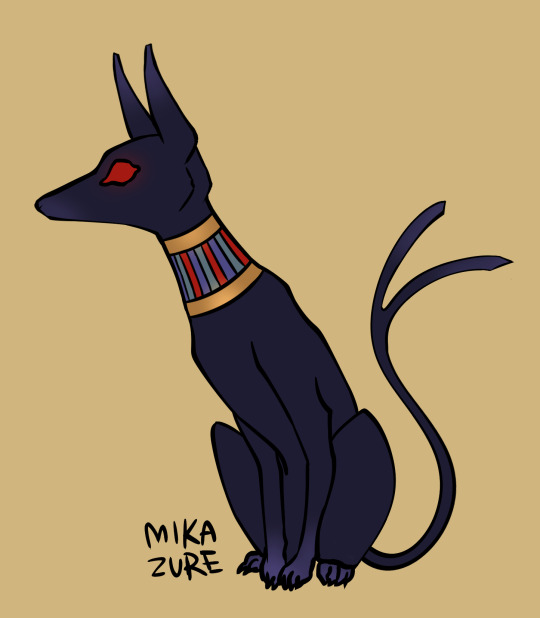
Typhonic beast/The Seth-animal/Sha
tattoo on me by me :3
#sha#oc#tattoo#mika tattoos#typhonic beast#set animal#egyptian mythology#moon knight oc#my art#mika draws#digital art#traditional art#original art
46 notes
·
View notes
